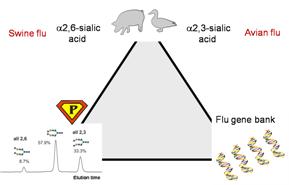Receptor specificity of the H1 hemagglutinin of the H1N1 swine-origin influenza A virus (S-OIV)
SUPERVISOR: FRIEDRICH ALTMANN
Project assigned to: LAURA NEUMANN
Background.
Influenza A viruses attack their hosts initially by binding to glyco-conjugates on the surface of susceptible cells. These receptors may either be glycoproteins or glycolipids. It is known that the crucial element of the receptor glycans is N-acetylneuraminic acid. The type of hemagglutinin of the virus determines whether the virus binds to glycoconjugates with α2,3- or α2,6-linked sialic acid (Neumann et al., 2009). The currently thriving H1N1 swine-origin influenza A virus (S-OIV) supposedly binds to α2,6-linkage as this linkage prevails in the human nasopharyngeal tract, whereas the recently notorious avian influenza virus H5N1 prefers α2,3-linked sialic acid as preferentially found in avian tissues (Baigent and McCauly, 2003). A glycan array study with avian viruses, however, revealed a more complex glycan specificity (Gambaryan et al., 2008).
Hitherto only one study has characterized the structures on epithelial tissues to which virus hemagglutinin binds (Guo et al., 2007). However, this study was performed with an outdated methodology. Furthermore, the study only investigated the protein-bound N-glycans of epithelial tissues.

Aims and methods.
The glycome of influenza virus-susceptible swine, chicken and human epithelia shall be investigated. The total glycome shall be compared with the hemagglutinin binding fraction. This may give new insights into the binding specificity of influenza virus hemagglutinins. This study shall focus on the hemagglutinin H1 of the new H1N1 swine-origin influenza A virus. The developed methodology will, however, be applicable to other virus strains.
The first part of this thesis will comprise two separate objectives:
I) Recombinant expression of S-OIV H1 hemagglutinin in the baculovirus/insect cell system as a soluble protein as well as in the form of virus-like particles. Purification of particles will be done by sucrose gradient centrifugation. The purified hemagglutinin will then be immobilized on a suitable chromatography matrix.
II) The glycome(s) of swine nasopharyngeal and chicken intestinal epithelia will be investigated by LC-ESI-MS. Tissues isolated by a veterinarian or similarly trained person will be homogenized and the insoluble fraction containing membranes and associated proteins will be further processed to obtain the N-glycans (by enzymatic cleavage), O-glycans (by alkaline β-elimination) and the lipid-linked glycans (by solvent extraction followed by enzymatic digestion). The glycan fractions will be reduced with sodium borohydride and then analyzed by our recently developed methodology for analysis of acidic, complex oligosaccharides (Pabst et al., 2007). For diantennary N-glycans this will yield a full assignment of structures (Pabst et al., 2007; Stadlmann et al., 2008), while for larger N-glycans only an inventory of the isomers, e.g. those with different sialic acid linkages, can at first be acquired. However, this is already more than the current standard methodologies (MALDI-TOF MS or HPLC analysis) are able to deliver. Moreover, our approach bears the ability to monitor all types of glycans, including e.g. sulfated structures.
In the second part of the thesis, the glycan (or glycopeptide in case of N- and O-glycans) pools will subjected to affinity-chromatography on immobilized hemagglutinin. We will develop a procedure for gentle elution of bound glycans avoiding desialylation of analytes and - if possible - denaturation of hemagglutinin. Finally the bound (as well as unbound) glycan fractions will again be subjected to the LC-ESI-MS methodology mentioned above. The structures of the bound glycan species will be elucidated by various analytical means including MS/MS or exoglycosidase digestion.
Baigent, S. J. McCauley, J. W. (2003) Influenza type A in humans, mammals and birds: determinants of virus virulence, host-range and interspecies transmission. Bioessays 25, 657-671
Gambaryan, A. S., Tuzikov, A. B., Pazynina, G. V., Desheva, J. A., Bovin, N. V., Matrosovich, M. N., Klimov, A. I. (2008) 6-sulfo sialyl Lewis X is the common receptor determinant recognized by H5, H6, H7 and H9 influenza viruses of terrestrial poultry. Virol. J. 5, 85
Guo, C. T., Takahashi, N., Yagi, H., Kato, K., Takahashi, T., Yi, S.-Q., Chen, Y., Ito, T., Otsuki, K., Kida, H., Kawaoka, Y., Hidari, K. I.-P. J., Miyamoto, D., Suzuki, T., Suzuki, Y. (2007) The quail and chicken intestine have sialyl-galactose sugar chains responsible for the binding of influenza A viruses to human type receptors. Glycobiology 17, 713-724
Neumann, G., Noda, T., Kawaoka, Y. (2009) Emergence and pandemic potential of swine-origin H1N1 influenza virus. Nature 459, 931-939
Pabst, M., Bondili, J. S., Stadlmann, J., Mach, L., Altmann, F. (2007) Mass + retention time = structure: a strategy for the analysis of N-glycans by carbon LC-ESI-MS and its application to fibrin N-glycans. Anal. Chem. 79, 5051-5057
Stadlmann, J., Pabst, M., Kolarich, D., Kunert, R., Altmann, F. (2008) Analysis of immunoglobulin glycosylation by LC-ESI-MS of glycopeptides and oligosaccharides. Proteomics 8, 2858-2871
